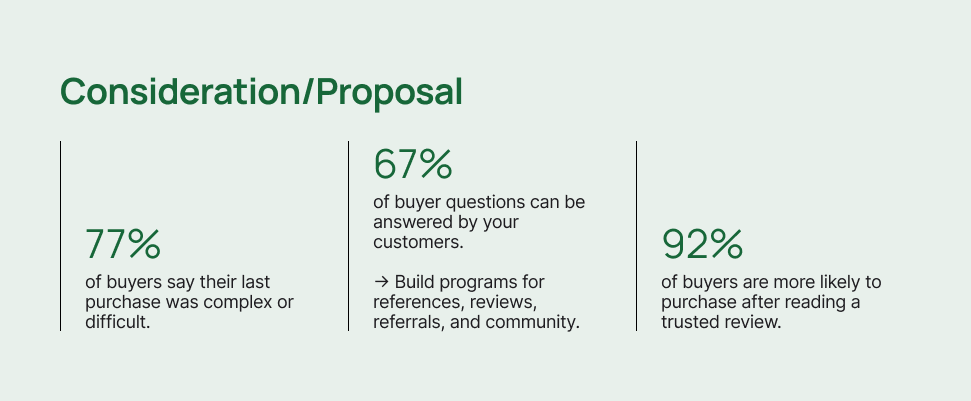We hear it all the time: “The B2B landscape has never been more competitive or more complex.” And it’s true.
The real battleground? The full customer lifecycle is under the microscope. From first touch to renewal, every interaction and touchpoint needs to prove its pipeline value and earn its keep.
Buyers expect more. CAC is rising. And the best marketing leaders aren’t just focused on leads — they’re aligning around lifetime value, retention, and a connected journey across every stage.
But here’s the real issue: Most B2B lifecycle models are outdated—treating the journey as something that starts post-sale and ends at churn. In reality, it begins the moment someone first engages and never truly ends. If the early experience feels generic or disconnected, trust, activation, and retention all suffer—and if churn happens, you’ve still got a shot to win them back.
When B2B Lifecycle Marketing Actually Starts
Effective B2B lifecycle marketing starts before the deal. Every early touchpoint shapes expectations, builds trust, and influences long-term value. Overlook early touchpoints and you risk a disjointed journey and weak retention.
To add to this, CRMs weren’t built for full-lifecycle orchestration. Most teams still rely on deal-stage logic, not customer behavior, leaving critical gaps in engagement and alignment.
This compartmentalized view creates blind spots. Without clear lifecycle stages, you miss the signals that drive retention, LTV, and board-level growth.
Retention and LTV require more than messaging — they demand alignment, visibility, and context-driven strategy.
What happens without cross-functional alignment and visibility? Your strategies become reactive, fragmented, and too generic to make a meaningful difference. You miss signals. You duplicate efforts. And ultimately, you lose customers who could have become long-term advocates.
It’s a fast track to churn.
On the flip side, when you treat the B2B Customer Lifecycle as a shared revenue engine, built on strategic data, stage ownership, and KPI alignment, you create compounding value and efficient growth.
If you’re serious about retention, CAC reduction, and long-term expansion, you need to act with precision at every stage of the lifecycle.
And you need a system built to make it happen.
Why Most Lifecycle Strategies Fail (and What to Do Instead)
For B2B companies, this journey isn’t just about selling a solution. It’s about building trust, delivering value consistently, and earning the right to stay in the room.
Unlike B2C lifecycles, which are often transactional and self-contained, B2B customer lifecycle marketing is:
- Longer, with extended evaluation periods and multi-stakeholder decisions
- More complex, involving layered service delivery and strategic alignment
- Inherently cross-functional, demanding close collaboration across marketing, sales, delivery, and customer success
As a result, visibility into each stage and access to integrated customer data become non-negotiable.
Without it, your tactics risk becoming disconnected from the customer’s actual needs and expectations—undermining your ability to retain and grow accounts over time.
Understand the 5 Critical Lifecycle Stages
Each stage in the pre & post-sale lifecycle presents unique opportunities and equally important risks.
To drive meaningful retention and sustainable growth, your strategy must be stage-specific, data-informed, and tightly aligned with your clients’ evolving expectations at every step of the journey.
Let’s take a closer look at each stage of the B2B customer lifecycle: what it represents, where companies typically miss the mark, and how every step can be optimized to drive retention and long-term impact.
And to make this actionable, we use a framework to unify strategy across teams.
- Awareness
- Consideration
- Onboarding
- Growth / Value Expansion
- Renewal or Advocacy
- Churn & Winback
CRM Funnel ≠ Lifecycle: Bridging the Post-Sale Gap
Most B2B revenue teams operate within a CRM-defined funnel: Lead → MQL → SQL → Opportunity → Closed Won/Closed Lost. These stages are essential for tracking deal progression and pipeline performance.
But they only tell part of the story.
CRMs are built to manage the path to purchase, but rarely capture what happens next. Once the deal is signed, the real work begins — delivering value, earning trust, and growing the relationship.
That’s where B2B Customer Lifecycle Marketing comes in — zeroing in on the post-sale stages that matter most: onboarding, adoption, expansion, and advocacy. It’s where revenue is protected, growth accelerates, and loyalty turns into long-term value.
If your strategy stops at Closed Won, you’re missing the part of the journey that matters most.
The 5 Critical Customer Lifecycle Stages: Where Tactics Meet Impact
Every team touches the customer lifecycle. But fragmented strategies, siloed data, and unclear ownership? They break trust, blur buying signals, and cost you renewals.
Let’s break it down.
Stage 1: Awareness: Target High-Fit Buyers, Not Volume
What it is: The first interaction a potential customer has with your brand—through paid media, organic search, content, events, or referrals.
Where teams fall short:
- Targeting is often too broad or MQL-centric
- Messaging lacks differentiation or fails to reflect the buyer’s pain points
How to optimize:
- Use intent data and enriched firmographics to reach high-fit accounts
- Map messaging to real business problems, not just features
- Align brand and demand so performance efforts reinforce positioning

Key metrics: % Qualified Traffic, Awareness-to-Interest Rate, Customer Acquisition Cost (CAC), CTR by Segment
Stage 2: Consideration/Proposal Stage: Build Trust That Converts to Pipeline
What it is:
- Prospects begin to explore solutions, vet vendors, and request information. Trust and credibility are being evaluated at the executive levels.
Where teams fall short:
- Sales and marketing lack alignment on who’s a good fit
- Content is either too top-funnel or too product-heavy
How to optimize:
- Equip sales with stage-specific assets (e.g., case studies, competitive analysis)
- Use behavioral scoring to identify genuine interest, not just downloads
- Orchestrate nurture flows around ICP pain points, not random offers
- Build a customer community to boost peer validation and brand trust

Key metrics: Lead-to-Opportunity Rate, LTV:CAC, Time to Convert, Influenced Pipeline by Lifecycle Content/Nurture, Opportunity Acceptance Rate
Stage 3: Onboarding: Deliver Value Early & Reduce Churn
What it is: The deal is closed—but this is where the real experience with additional teams begins. Set the tone early with value delivery.
Where teams fall short:
- Handoff between sales and delivery feels disjointed
- Customers are unclear on expectations or milestones
How to optimize:
- Build an automated and formal onboarding framework in your CRM with clear success metrics and alerts/SLAs for all involved teams.
- Assign internal accountability across marketing, sales, and success.
- Over-communicate early wins to reinforce the decision the customer made when choosing you.

Key metrics: Time to First Value (TTFV), Customer Satisfaction Scores (CSAT), Internal SLA Adherence, Onboarding Completion Rate.
Stage 4: Growth / Expansion: Drive Deeper Value and Create Stickiness
What it is: The customer is engaged—now you scale value and deepen the partnership.
Where teams fall short:
- No lifecycle/customer marketing beyond initial onboarding
- Upsell conversations only happen at renewal
How to optimize:
- Use usage data, health scores, and feedback loops to surface expansion triggers.
- Launch ongoing education campaigns to encourage deeper platform adoption.
- Create value-based touchpoints that proactively solve for tomorrow’s needs.
- Build forecastable revenue pathways using signals you already own.

Key metrics: Net Revenue Retention (NRR), Monthly Revenue Retention (MRR), Customer Engagement Scores (CSATs or NPS).
Stage 5: Advocacy: Turn Success into Renewals and Referrals
What it is: It’s time to renew—and ideally, expand or refer. Loyalty becomes a measurable outcome.
Where teams fall short:
- Retention is treated as an operations function, not a strategic lever
- Advocacy is passive, not built into the experience
How to optimize:
- Develop QBRs that focus on business impact, not just activity metrics
- Continue to launch customer marketing initiatives with personalized advocacy asks
- Use testimonials and case studies to elevate champions internally and externally
- Turn customer marketing into a growth channel- not just a nice-to-have.

Key metrics: Customer Lifetime Value (CLV), Renewal Probability, Customer Health, Net Promoter Score (NPS), Referral Rate, Advocacy Participation, Open/Unresolved Issue Logs
Stage 6: Churn & Post-Churn: Turn Customer Exits into Returning Profit
What it is: The customer has left—but the relationship doesn’t have to end. In a mature lifecycle engine, churn isn’t treated as a final stage. Instead, it becomes an opportunity to re-engage, re-educate, and re-earn trust.
Where teams fall short:
- Churned accounts are written off as lost, with no proactive reactivation effort
- Post-churn insights aren’t analyzed or actioned for future win-back plays
- There’s no defined motion for proving value again—at scale
How to optimize:
- Use churn diagnostics to segment accounts by reactivation likelihood and intent signals
- Design short, low-friction campaigns that allow your team to re-engage the ex-contacts with genuine, heart-felt messaging—without a full sales pitch
- Capture success stories from returners to build “boomerang” case studies that inspire trust and reduce re-entry friction
- Leverage your existing data to ensure you can solve for their original pain points to ensure a seamless second experience with your brand

Key metrics: Reactivation Rate, Post-Mortems, CSATs, Churn Recovery Rate
Lifecycle Alignment = Predictable Growth
Optimizing the B2B customer lifecycle isn’t about patching one stage — it’s about creating alignment across every stage to drive consistent, compounding value.
When marketing applies stage specific tactics, everything changes:
- You anticipate behavior, not chase it. Example: Pre-renewal campaigns trigger 90 days out, not after churn risk hits.
- You deliver value before it’s expected. Example: Onboarding sequences map content to time-to-first-value benchmarks.
- You turn retention into a revenue engine. Example: Expansion plays trigger automatically when usage signals spike.
Ready to Scale? Build Your Lifecycle Engine
A great product gets you in the door.
A seamless customer experience drives efficient growth and lasting retention. That’s how you win and scale in today’s market.
That starts with:
- A data-driven strategy for B2B customer lifecycle management
- Aligned KPIs across teams
- Tailored experiences at every stage
- And the confidence to communicate that value to your stakeholders
At Directive, we’ve seen firsthand how powerful lifecycle alignment can be. That’s why we help our customers at every stage of their lifecycle through Go-To-Market, Paid Media, Content & SEO, Revenue Operations, CRO and Start Ups.
Ready to turn retention into revenue, align your teams, and predict your pipeline? Let’s build the Lifecycle Management engine that powers efficient growth.
Sources:
¹ CEB (now Gartner), The Digital Evolution in B2B Marketing.
² FocusVision, B2B Buyer’s Survey 2020, via MarTech.org.
³ GE Capital Retail Bank, Major Purchase Shopper Study.
⁴ Gartner, The New B2B Buying Journey and Its Implication for Sales (2019).
⁵ Paul Greenberg, CRM at the Speed of Light, Fourth Edition: Social CRM 2.0 Strategies, Tools, and Techniques for Engaging Your Customers (2010).
⁶ G2 and Heinz Marketing, The Power of Peer Influence.
⁷ Totango, State of the Customer Success Industry Report.
⁸ Bain & Company, The Economics of Loyalty.
⁹ Forbes, The Value Of Investing In Loyal Customers (2020). Available at: Forbes.
Also cited in: HubSpot, Customer Retention Statistics. Available at: HubSpot Blog.
¹⁰ Nielsen and Deloitte, Customer Behavior and the Power of Word-of-Mouth.
¹¹ HelpOnClick, Why Customer Win-Back Campaigns Are Important, citing Marketing Metrics. Available at: HelpOnClick Blog.
-
 Lea Amiri
Lea Amiri
Did you enjoy this article?
Share it with someone!
